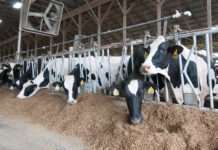Contact: Marsha Boswell, [email protected]
For audio version, visit kswheat.com.
The 2023 Wheat Quality Council’s Hard Winter Wheat Tour across Kansas wrapped up on May 18. During the three days of wheat scouting, tour participants traveled six routes from Manhattan to Colby to Wichita and back to Manhattan. This year’s tour hosted 106 people from 22 U.S. states plus Mexico, Canada and Colombia, in 27 vehicles while traveling across the state.
The three-day average calculated yield for the fields that will be harvested was 30 bushels per acre.
While an estimated 8.1 million acres of wheat were planted in the fall, the Kansas wheat crop has suffered from a multi-year drought, which has robbed the state’s yield potential and resulted in many abandoned fields.
The official tour projection for total production of wheat to be harvested in Kansas is 178 million bushels, indicating that tour participants thought abandonment might be quite a bit higher than normal at 26.75%. The production number is the average of estimated predictions from tour participants who gathered information from 652 fields across the state. Based on May 1 conditions, NASS predicted the crop to be higher at 191 million bushels, with a yield of 29 bushels per acre and abandonment at 18.5%.
On Thursday, yields in areas between Wichita and Manhattan were better than what participants had seen earlier on the tour, improving as they moved north, averaging 44.1 bushels per acre.
For fields that have not yet headed out, scouts use an early season formula model to calculate the potential yield of the fields. The model uses an average head weight based on 2013-2022 Kansas wheat objective yield data. For the fields that had already headed, attendees were able to use a late-season formula to calculate yields, based on number of wheat heads, number of spikelets and kernels per spikelet. These formulas are provided by USDA’s National Agricultural Statistics Service. The formulas do not take into consideration variables such as weed pressure, disease and pests. Tour scouts didn’t see much disease pressure this year with the drought conditions.
The tour captures a moment in time for the yield potential for fields across the state. These fields are still 3-6 weeks from harvest. A lot can happen during that time to affect final yields and production.
The tour is sponsored by the Wheat Quality Council, which is a coordinated effort by breeders, producers and processors to improve wheat and flour quality. The primary goals of the tour are to make connections within the wheat industry, allow participants to meet wheat farmers and see the growing crop and to highlight the agriculture industry.
###



